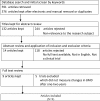The Effects of Transdermal Estrogen Delivery on Bone Mineral Density in Postmenopausal Women: A Meta-analysis
- PMID: 28496491
- PMCID: PMC5423263
The Effects of Transdermal Estrogen Delivery on Bone Mineral Density in Postmenopausal Women: A Meta-analysis
Abstract
Due to its minimal systematic adverse effects, transdermal estrogen is widely used for the prevention of osteoporosis in postmenopausal women. The present meta-analysis aimed to clarify the effects of transdermal estrogen on bone mineral density (BMD) of postmenopausal women. Studies were identified by searching electronic databases including Cochrane Library, MEDLINE, Embase , and CINAHL databases, and also the Sciences Citation Index. Systematic review of articles was published between January 1989 to February 2016.Reference lists of the included articles were also evaluated and consultations were made with relevant experts. While 132 studies included the desired keywords, only nine clinical trials met the inclusion criteria and were finally reviewed. The pooled percent change in BMD was statistically significant in favor of transdermal estrogen. According to resulting pooled estimate, lumbar spine BMD one and two years after transdermal estrogen therapy was respectively 3.4% (95% CI: 1.7-5.1) and 3.7% (95% CI: 1.7-5.7) higher than the baseline values. The test for heterogeneity was not statistically significant based on the I2 heterogeneity index. One-two years of transdermal estrogen delivery can effectively increase BMD and protect the bone structure in postmenopausal women.
Keywords: Bone mineral density; Menopause; Transdermal estrogen.
Conflict of interest statement
We have no financial interests related to the material in this manuscript.
Figures
Similar articles
-
Comparative effects on bone mineral density of tibolone, transdermal estrogen and oral estrogen/progestogen therapy in postmenopausal women.Gynecol Endocrinol. 1996 Dec;10(6):413-20. doi: 10.3109/09513599609023606. Gynecol Endocrinol. 1996. PMID: 9032569
-
Effect of transdermal estrogen therapy on bone mineral density in postmenopausal korean women.J Menopausal Med. 2014 Dec;20(3):111-7. doi: 10.6118/jmm.2014.20.3.111. Epub 2014 Dec 24. J Menopausal Med. 2014. PMID: 25580422 Free PMC article.
-
Meta-analysis of walking for preservation of bone mineral density in postmenopausal women.Bone. 2008 Sep;43(3):521-31. doi: 10.1016/j.bone.2008.05.012. Epub 2008 May 26. Bone. 2008. PMID: 18602880
-
[Effects of estrogen therapy on bone mass in postmenopausal women with osteopenia].Medicina (B Aires). 1995;55(5 Pt 1):408-14. Medicina (B Aires). 1995. PMID: 8728770 Spanish.
-
Effects of Oestrogen Treatment on Skeletal Response to Exercise in the Hips and Spine in Postmenopausal Women: A Meta-Analysis.Sports Med. 2015 Aug;45(8):1163-73. doi: 10.1007/s40279-015-0338-3. Sports Med. 2015. PMID: 26003475 Review.
Cited by
-
Update on Menopausal Hormone Therapy for Fracture Prevention.Curr Osteoporos Rep. 2019 Dec;17(6):465-473. doi: 10.1007/s11914-019-00549-3. Curr Osteoporos Rep. 2019. PMID: 31741221 Free PMC article. Review.
-
Teriparatide in the Treatment of Severe Postmenopausal Osteoporosis: A Cost-Utility Analysis.Iran J Pharm Res. 2019 Spring;18(2):1073-1085. doi: 10.22037/ijpr.2019.1100679. Iran J Pharm Res. 2019. PMID: 31531089 Free PMC article.
-
Estrogen and bones after menopause: a reappraisal of data and future perspectives.Hormones (Athens). 2021 Mar;20(1):13-21. doi: 10.1007/s42000-020-00218-6. Epub 2020 Jun 9. Hormones (Athens). 2021. PMID: 32519298 Review.
-
Social determinants of domestic violence against suburban women in developing countries: a systematic review.Obstet Gynecol Sci. 2021 Mar;64(2):131-142. doi: 10.5468/ogs.20211. Epub 2021 Jan 28. Obstet Gynecol Sci. 2021. PMID: 33503736 Free PMC article.
-
Genome-wide Association Study of Estradiol Levels and the Causal Effect of Estradiol on Bone Mineral Density.J Clin Endocrinol Metab. 2021 Oct 21;106(11):e4471-e4486. doi: 10.1210/clinem/dgab507. J Clin Endocrinol Metab. 2021. PMID: 34255042 Free PMC article.
References
-
- Abdi F, Mobedi H, Mosaffa N, Dolatian M, Tehrani FR. Hormone Therapy for Relieving Postmenopausal Vasomotor Symptoms: A Systematic Review. Archives of Iranian Medicine. 2016;19:141–6. - PubMed
-
- Palacios S, Currie H, Mikkola TS, Dragon E. Perspective on prescribing conjugated estrogens/bazedoxifene for estrogen-deficiency symptoms of menopause: A practical guide. Maturitas. 2015;80:435–40. - PubMed
-
- Khan A, Fortier M, Fortier M, Reid R, Abramson BL, Blake J. Osteoporosis in menopause. Journal of obstetrics and gynaecology Canada : JOGC. 2014;36:839–43. - PubMed
-
- Seifert-Klauss V, Fillenberg S, Schneider H, Luppa P, Mueller D, Kiechle M. Bone loss in premenopausal, perimenopausal and postmenopausal women: results of a prospective observational study over 9 years. Climacteric . 2012;15:433–40. - PubMed
LinkOut - more resources
Full Text Sources
Miscellaneous




